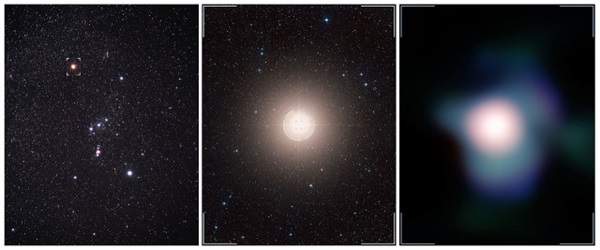When Betelgeuse goes supernova, what will it look like from Earth? – Astronomy Magazine
This collage zooms in on the constellation Orion (left) to one of the sharpest images ever taken of Betelgeuse (far right).
ESO, P. Kervella, Digitized Sky Survey 2 and A. Fujii
To catch a dying star
But for scientists, Betelgeuse doesn’t have to explode to be interesting. It’s big and bright, making it relatively easy to study.
“It’s fascinating from an astronomer’s perspective because we can study a star that is nearing the end of its life quite closely,” Nance says. “There’s some fascinating physics going on in the internal structure of Betelgeuse.”
Their best guess as to what’s going on right now stems from what astronomers already know about the star and others like it. As Nance explains, that research shows Betelgeuse’s brightness could be changing for a number of reasons. Some astronomers even suspect that several different dimming mechanisms are playing out at once.
As their nuclear fuel runs out near the ends of their lives, red supergiant stars start to bloat and form growing envelopes of gas and dust. And as this envelope gets bigger, the star’s brightness grows. But that’s not the only way a star like Betelgeuse can dim and brighten. Red supergiant stars also have enormous convective cells on their surfaces — like much larger versions of those on our Sun — where turbulence makes hot material rise from inside the star. Once it reaches the surface, part of that material erupts violently into space like a giant, radioactive belch, which can temporarily change its brightness.
And Betelgeuse’s dimming could even be evidence that it is about to explode. As material erupts from a dying star’s surface, it typically collides, which makes it shine brighter. However, Nance says it’s possible that this material is shrouding the star instead, making it dimmer.
Whatever the root cause, the strange behavior should ultimately offer new insights into the dying days of red supergiant stars. And humanity will have a front-row seat.
“Betelgeuse provides a great setting for astronomers to study these last stages of nuclear burning before it explodes,” Nance says.







